Leadership: Qualities, Development, Management Styles & Experiences
VerifiedAdded on 2023/06/11
|11
|3442
|433
Report
AI Summary
This report provides an overview of leadership, exploring essential qualities, development strategies, and the distinction between leadership and management. It discusses theories like the Greatman theory by Thomas Carlyle and Ralph Stogdill's traits theory, emphasizing the importance of traits such as intelligence, alertness, responsibility, self-confidence, and intuition in effective leaders. The report also examines how leadership can be developed through approaches like Katz's three-skill approach (technical, conceptual, and interpersonal skills) and Mumford's skill model, highlighting individual attributes, competencies, career experiences, and environmental influences. Furthermore, it differentiates leadership from management, referencing the Blake Mouton Grid and Mintzberg's management roles (interpersonal, informational, and decisional) to illustrate the contrasting focuses on influencing individuals versus managing tasks. The report concludes with personal reflections on leadership experiences and learnings.
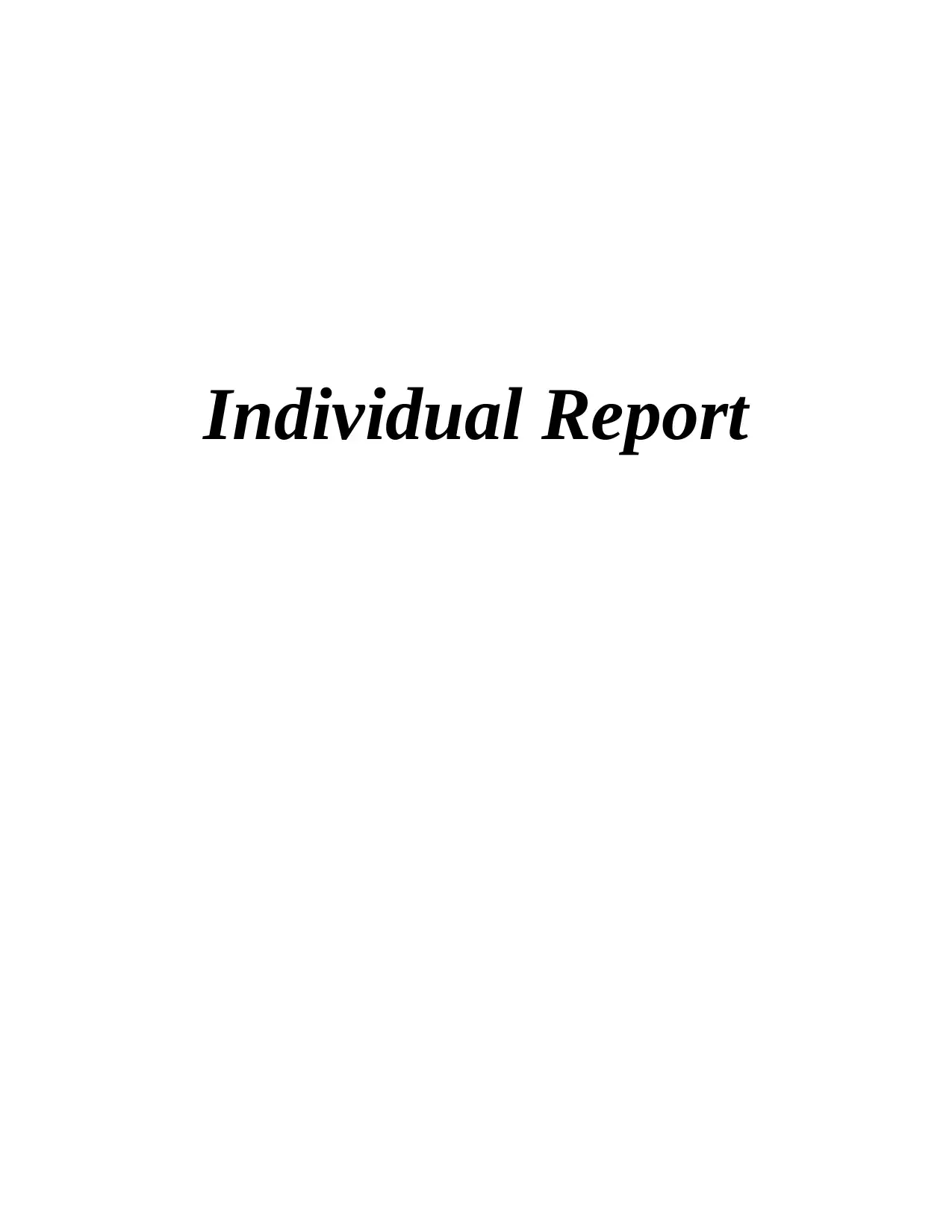
Individual Report
Paraphrase This Document
Need a fresh take? Get an instant paraphrase of this document with our AI Paraphraser
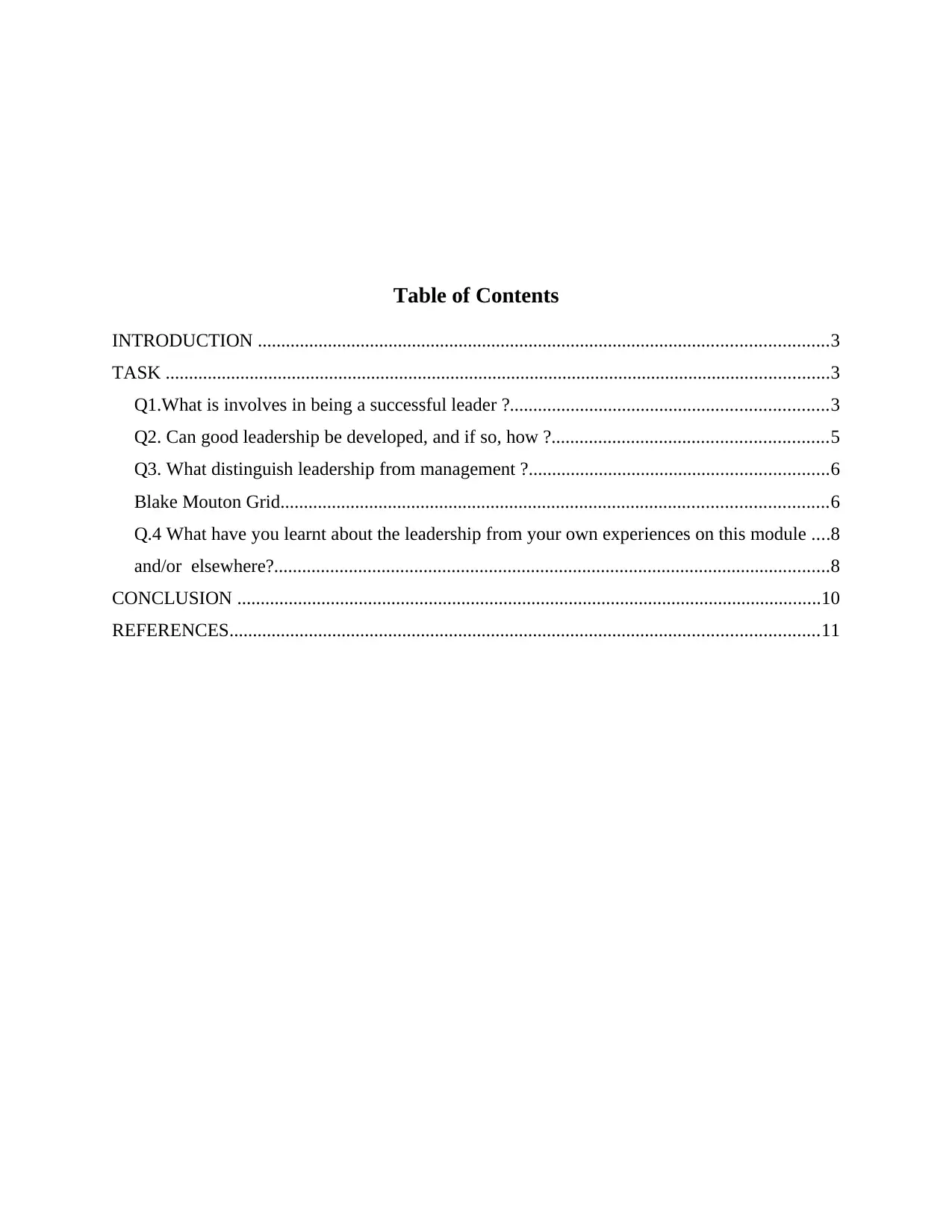
Table of Contents
INTRODUCTION ..........................................................................................................................3
TASK ..............................................................................................................................................3
Q1.What is involves in being a successful leader ?....................................................................3
Q2. Can good leadership be developed, and if so, how ?...........................................................5
Q3. What distinguish leadership from management ?................................................................6
Blake Mouton Grid.....................................................................................................................6
Q.4 What have you learnt about the leadership from your own experiences on this module ....8
and/or elsewhere?.......................................................................................................................8
CONCLUSION .............................................................................................................................10
REFERENCES..............................................................................................................................11
INTRODUCTION ..........................................................................................................................3
TASK ..............................................................................................................................................3
Q1.What is involves in being a successful leader ?....................................................................3
Q2. Can good leadership be developed, and if so, how ?...........................................................5
Q3. What distinguish leadership from management ?................................................................6
Blake Mouton Grid.....................................................................................................................6
Q.4 What have you learnt about the leadership from your own experiences on this module ....8
and/or elsewhere?.......................................................................................................................8
CONCLUSION .............................................................................................................................10
REFERENCES..............................................................................................................................11
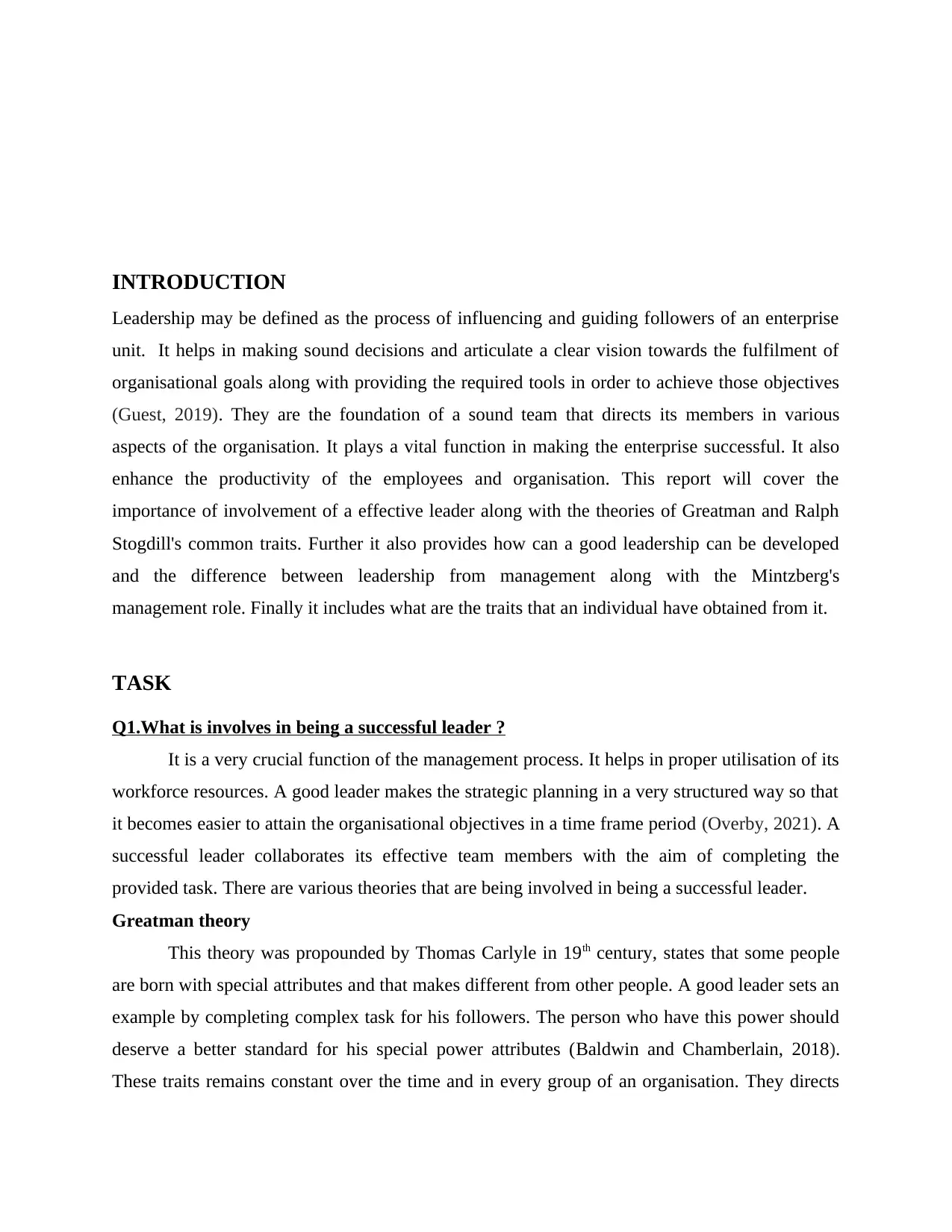
INTRODUCTION
Leadership may be defined as the process of influencing and guiding followers of an enterprise
unit. It helps in making sound decisions and articulate a clear vision towards the fulfilment of
organisational goals along with providing the required tools in order to achieve those objectives
(Guest, 2019). They are the foundation of a sound team that directs its members in various
aspects of the organisation. It plays a vital function in making the enterprise successful. It also
enhance the productivity of the employees and organisation. This report will cover the
importance of involvement of a effective leader along with the theories of Greatman and Ralph
Stogdill's common traits. Further it also provides how can a good leadership can be developed
and the difference between leadership from management along with the Mintzberg's
management role. Finally it includes what are the traits that an individual have obtained from it.
TASK
Q1.What is involves in being a successful leader ?
It is a very crucial function of the management process. It helps in proper utilisation of its
workforce resources. A good leader makes the strategic planning in a very structured way so that
it becomes easier to attain the organisational objectives in a time frame period (Overby, 2021). A
successful leader collaborates its effective team members with the aim of completing the
provided task. There are various theories that are being involved in being a successful leader.
Greatman theory
This theory was propounded by Thomas Carlyle in 19th century, states that some people
are born with special attributes and that makes different from other people. A good leader sets an
example by completing complex task for his followers. The person who have this power should
deserve a better standard for his special power attributes (Baldwin and Chamberlain, 2018).
These traits remains constant over the time and in every group of an organisation. They directs
Leadership may be defined as the process of influencing and guiding followers of an enterprise
unit. It helps in making sound decisions and articulate a clear vision towards the fulfilment of
organisational goals along with providing the required tools in order to achieve those objectives
(Guest, 2019). They are the foundation of a sound team that directs its members in various
aspects of the organisation. It plays a vital function in making the enterprise successful. It also
enhance the productivity of the employees and organisation. This report will cover the
importance of involvement of a effective leader along with the theories of Greatman and Ralph
Stogdill's common traits. Further it also provides how can a good leadership can be developed
and the difference between leadership from management along with the Mintzberg's
management role. Finally it includes what are the traits that an individual have obtained from it.
TASK
Q1.What is involves in being a successful leader ?
It is a very crucial function of the management process. It helps in proper utilisation of its
workforce resources. A good leader makes the strategic planning in a very structured way so that
it becomes easier to attain the organisational objectives in a time frame period (Overby, 2021). A
successful leader collaborates its effective team members with the aim of completing the
provided task. There are various theories that are being involved in being a successful leader.
Greatman theory
This theory was propounded by Thomas Carlyle in 19th century, states that some people
are born with special attributes and that makes different from other people. A good leader sets an
example by completing complex task for his followers. The person who have this power should
deserve a better standard for his special power attributes (Baldwin and Chamberlain, 2018).
These traits remains constant over the time and in every group of an organisation. They directs
⊘ This is a preview!⊘
Do you want full access?
Subscribe today to unlock all pages.

Trusted by 1+ million students worldwide
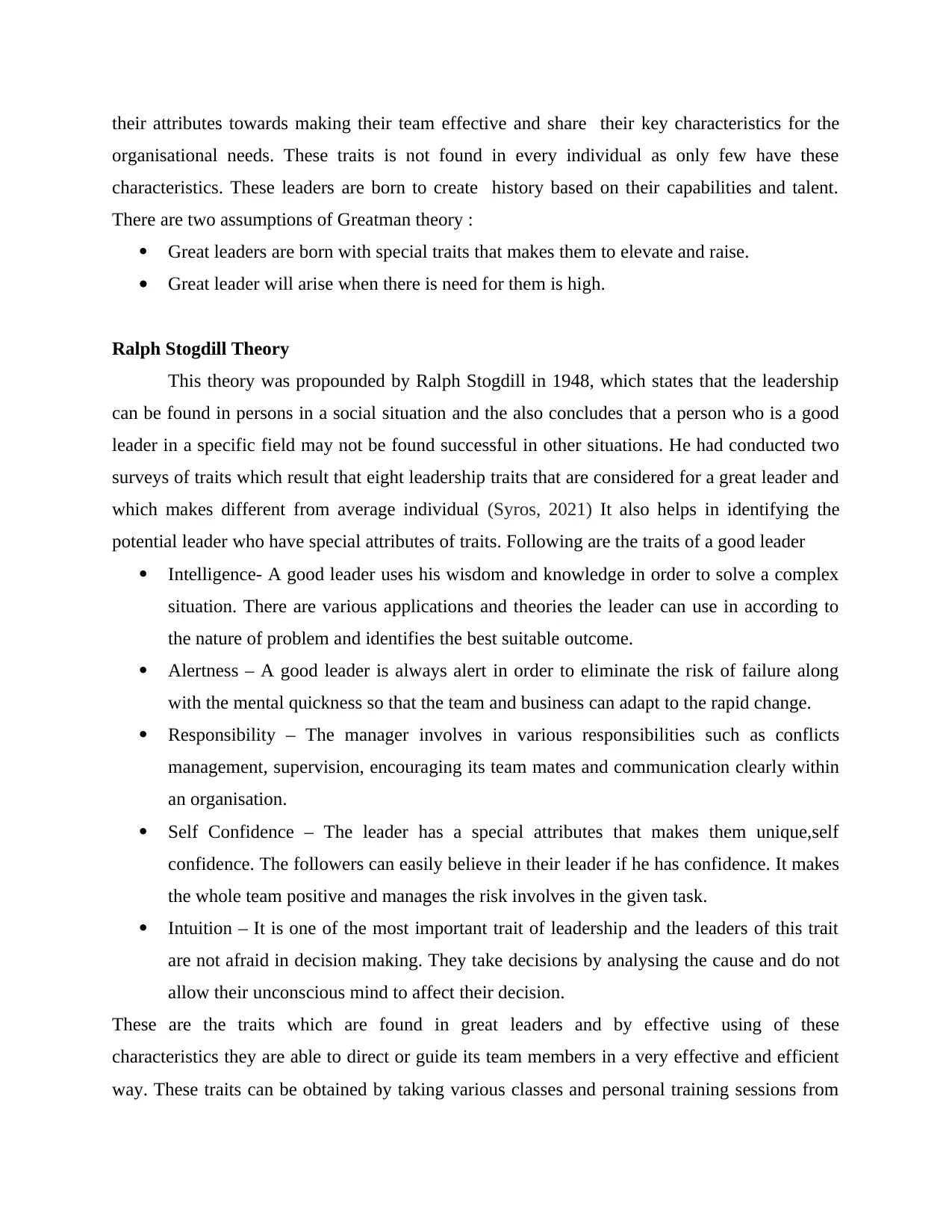
their attributes towards making their team effective and share their key characteristics for the
organisational needs. These traits is not found in every individual as only few have these
characteristics. These leaders are born to create history based on their capabilities and talent.
There are two assumptions of Greatman theory :
Great leaders are born with special traits that makes them to elevate and raise.
Great leader will arise when there is need for them is high.
Ralph Stogdill Theory
This theory was propounded by Ralph Stogdill in 1948, which states that the leadership
can be found in persons in a social situation and the also concludes that a person who is a good
leader in a specific field may not be found successful in other situations. He had conducted two
surveys of traits which result that eight leadership traits that are considered for a great leader and
which makes different from average individual (Syros, 2021) It also helps in identifying the
potential leader who have special attributes of traits. Following are the traits of a good leader
Intelligence- A good leader uses his wisdom and knowledge in order to solve a complex
situation. There are various applications and theories the leader can use in according to
the nature of problem and identifies the best suitable outcome.
Alertness – A good leader is always alert in order to eliminate the risk of failure along
with the mental quickness so that the team and business can adapt to the rapid change.
Responsibility – The manager involves in various responsibilities such as conflicts
management, supervision, encouraging its team mates and communication clearly within
an organisation.
Self Confidence – The leader has a special attributes that makes them unique,self
confidence. The followers can easily believe in their leader if he has confidence. It makes
the whole team positive and manages the risk involves in the given task.
Intuition – It is one of the most important trait of leadership and the leaders of this trait
are not afraid in decision making. They take decisions by analysing the cause and do not
allow their unconscious mind to affect their decision.
These are the traits which are found in great leaders and by effective using of these
characteristics they are able to direct or guide its team members in a very effective and efficient
way. These traits can be obtained by taking various classes and personal training sessions from
organisational needs. These traits is not found in every individual as only few have these
characteristics. These leaders are born to create history based on their capabilities and talent.
There are two assumptions of Greatman theory :
Great leaders are born with special traits that makes them to elevate and raise.
Great leader will arise when there is need for them is high.
Ralph Stogdill Theory
This theory was propounded by Ralph Stogdill in 1948, which states that the leadership
can be found in persons in a social situation and the also concludes that a person who is a good
leader in a specific field may not be found successful in other situations. He had conducted two
surveys of traits which result that eight leadership traits that are considered for a great leader and
which makes different from average individual (Syros, 2021) It also helps in identifying the
potential leader who have special attributes of traits. Following are the traits of a good leader
Intelligence- A good leader uses his wisdom and knowledge in order to solve a complex
situation. There are various applications and theories the leader can use in according to
the nature of problem and identifies the best suitable outcome.
Alertness – A good leader is always alert in order to eliminate the risk of failure along
with the mental quickness so that the team and business can adapt to the rapid change.
Responsibility – The manager involves in various responsibilities such as conflicts
management, supervision, encouraging its team mates and communication clearly within
an organisation.
Self Confidence – The leader has a special attributes that makes them unique,self
confidence. The followers can easily believe in their leader if he has confidence. It makes
the whole team positive and manages the risk involves in the given task.
Intuition – It is one of the most important trait of leadership and the leaders of this trait
are not afraid in decision making. They take decisions by analysing the cause and do not
allow their unconscious mind to affect their decision.
These are the traits which are found in great leaders and by effective using of these
characteristics they are able to direct or guide its team members in a very effective and efficient
way. These traits can be obtained by taking various classes and personal training sessions from
Paraphrase This Document
Need a fresh take? Get an instant paraphrase of this document with our AI Paraphraser
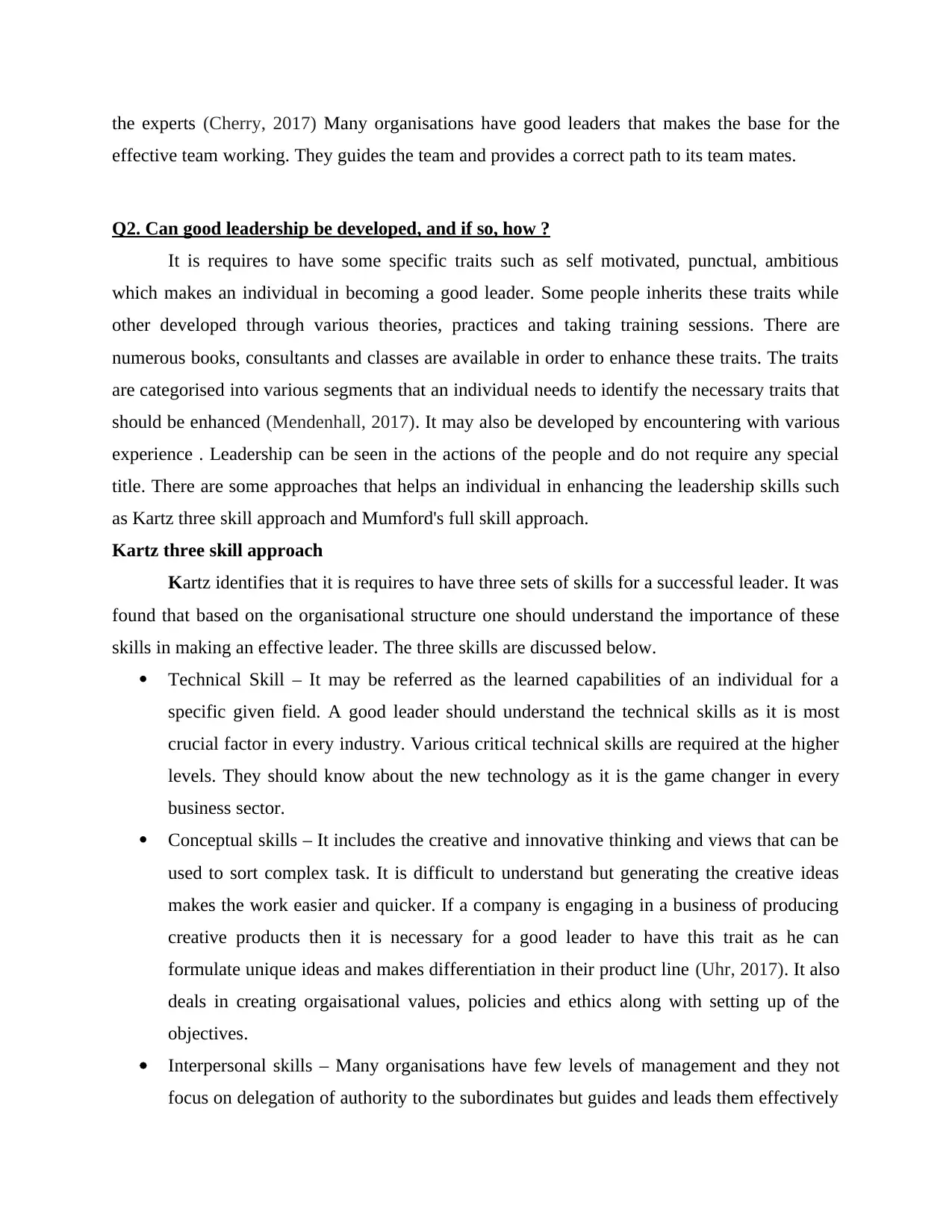
the experts (Cherry, 2017) Many organisations have good leaders that makes the base for the
effective team working. They guides the team and provides a correct path to its team mates.
Q2. Can good leadership be developed, and if so, how ?
It is requires to have some specific traits such as self motivated, punctual, ambitious
which makes an individual in becoming a good leader. Some people inherits these traits while
other developed through various theories, practices and taking training sessions. There are
numerous books, consultants and classes are available in order to enhance these traits. The traits
are categorised into various segments that an individual needs to identify the necessary traits that
should be enhanced (Mendenhall, 2017). It may also be developed by encountering with various
experience . Leadership can be seen in the actions of the people and do not require any special
title. There are some approaches that helps an individual in enhancing the leadership skills such
as Kartz three skill approach and Mumford's full skill approach.
Kartz three skill approach
Kartz identifies that it is requires to have three sets of skills for a successful leader. It was
found that based on the organisational structure one should understand the importance of these
skills in making an effective leader. The three skills are discussed below.
Technical Skill – It may be referred as the learned capabilities of an individual for a
specific given field. A good leader should understand the technical skills as it is most
crucial factor in every industry. Various critical technical skills are required at the higher
levels. They should know about the new technology as it is the game changer in every
business sector.
Conceptual skills – It includes the creative and innovative thinking and views that can be
used to sort complex task. It is difficult to understand but generating the creative ideas
makes the work easier and quicker. If a company is engaging in a business of producing
creative products then it is necessary for a good leader to have this trait as he can
formulate unique ideas and makes differentiation in their product line (Uhr, 2017). It also
deals in creating orgaisational values, policies and ethics along with setting up of the
objectives.
Interpersonal skills – Many organisations have few levels of management and they not
focus on delegation of authority to the subordinates but guides and leads them effectively
effective team working. They guides the team and provides a correct path to its team mates.
Q2. Can good leadership be developed, and if so, how ?
It is requires to have some specific traits such as self motivated, punctual, ambitious
which makes an individual in becoming a good leader. Some people inherits these traits while
other developed through various theories, practices and taking training sessions. There are
numerous books, consultants and classes are available in order to enhance these traits. The traits
are categorised into various segments that an individual needs to identify the necessary traits that
should be enhanced (Mendenhall, 2017). It may also be developed by encountering with various
experience . Leadership can be seen in the actions of the people and do not require any special
title. There are some approaches that helps an individual in enhancing the leadership skills such
as Kartz three skill approach and Mumford's full skill approach.
Kartz three skill approach
Kartz identifies that it is requires to have three sets of skills for a successful leader. It was
found that based on the organisational structure one should understand the importance of these
skills in making an effective leader. The three skills are discussed below.
Technical Skill – It may be referred as the learned capabilities of an individual for a
specific given field. A good leader should understand the technical skills as it is most
crucial factor in every industry. Various critical technical skills are required at the higher
levels. They should know about the new technology as it is the game changer in every
business sector.
Conceptual skills – It includes the creative and innovative thinking and views that can be
used to sort complex task. It is difficult to understand but generating the creative ideas
makes the work easier and quicker. If a company is engaging in a business of producing
creative products then it is necessary for a good leader to have this trait as he can
formulate unique ideas and makes differentiation in their product line (Uhr, 2017). It also
deals in creating orgaisational values, policies and ethics along with setting up of the
objectives.
Interpersonal skills – Many organisations have few levels of management and they not
focus on delegation of authority to the subordinates but guides and leads them effectively
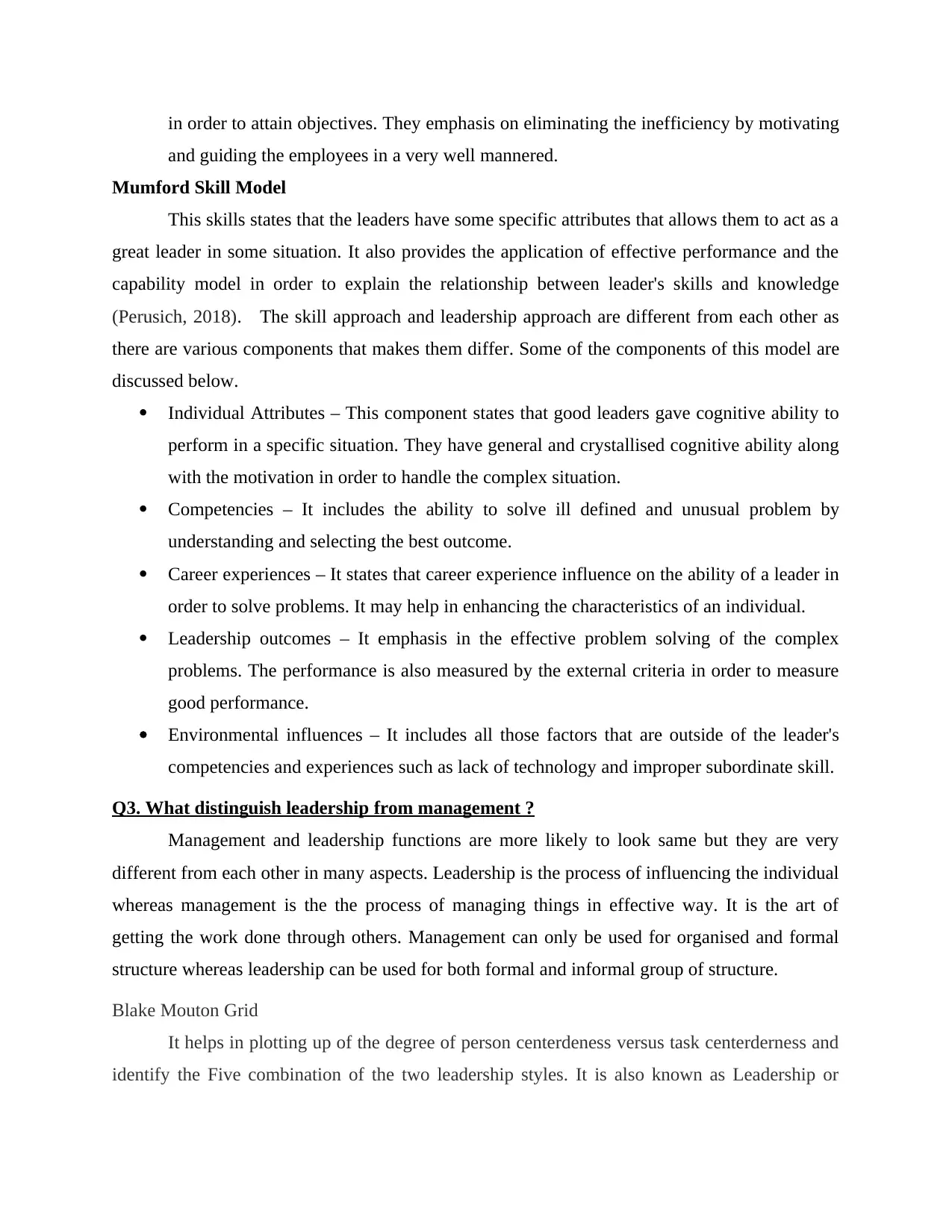
in order to attain objectives. They emphasis on eliminating the inefficiency by motivating
and guiding the employees in a very well mannered.
Mumford Skill Model
This skills states that the leaders have some specific attributes that allows them to act as a
great leader in some situation. It also provides the application of effective performance and the
capability model in order to explain the relationship between leader's skills and knowledge
(Perusich, 2018). The skill approach and leadership approach are different from each other as
there are various components that makes them differ. Some of the components of this model are
discussed below.
Individual Attributes – This component states that good leaders gave cognitive ability to
perform in a specific situation. They have general and crystallised cognitive ability along
with the motivation in order to handle the complex situation.
Competencies – It includes the ability to solve ill defined and unusual problem by
understanding and selecting the best outcome.
Career experiences – It states that career experience influence on the ability of a leader in
order to solve problems. It may help in enhancing the characteristics of an individual.
Leadership outcomes – It emphasis in the effective problem solving of the complex
problems. The performance is also measured by the external criteria in order to measure
good performance.
Environmental influences – It includes all those factors that are outside of the leader's
competencies and experiences such as lack of technology and improper subordinate skill.
Q3. What distinguish leadership from management ?
Management and leadership functions are more likely to look same but they are very
different from each other in many aspects. Leadership is the process of influencing the individual
whereas management is the the process of managing things in effective way. It is the art of
getting the work done through others. Management can only be used for organised and formal
structure whereas leadership can be used for both formal and informal group of structure.
Blake Mouton Grid
It helps in plotting up of the degree of person centerdeness versus task centerderness and
identify the Five combination of the two leadership styles. It is also known as Leadership or
and guiding the employees in a very well mannered.
Mumford Skill Model
This skills states that the leaders have some specific attributes that allows them to act as a
great leader in some situation. It also provides the application of effective performance and the
capability model in order to explain the relationship between leader's skills and knowledge
(Perusich, 2018). The skill approach and leadership approach are different from each other as
there are various components that makes them differ. Some of the components of this model are
discussed below.
Individual Attributes – This component states that good leaders gave cognitive ability to
perform in a specific situation. They have general and crystallised cognitive ability along
with the motivation in order to handle the complex situation.
Competencies – It includes the ability to solve ill defined and unusual problem by
understanding and selecting the best outcome.
Career experiences – It states that career experience influence on the ability of a leader in
order to solve problems. It may help in enhancing the characteristics of an individual.
Leadership outcomes – It emphasis in the effective problem solving of the complex
problems. The performance is also measured by the external criteria in order to measure
good performance.
Environmental influences – It includes all those factors that are outside of the leader's
competencies and experiences such as lack of technology and improper subordinate skill.
Q3. What distinguish leadership from management ?
Management and leadership functions are more likely to look same but they are very
different from each other in many aspects. Leadership is the process of influencing the individual
whereas management is the the process of managing things in effective way. It is the art of
getting the work done through others. Management can only be used for organised and formal
structure whereas leadership can be used for both formal and informal group of structure.
Blake Mouton Grid
It helps in plotting up of the degree of person centerdeness versus task centerderness and
identify the Five combination of the two leadership styles. It is also known as Leadership or
⊘ This is a preview!⊘
Do you want full access?
Subscribe today to unlock all pages.

Trusted by 1+ million students worldwide
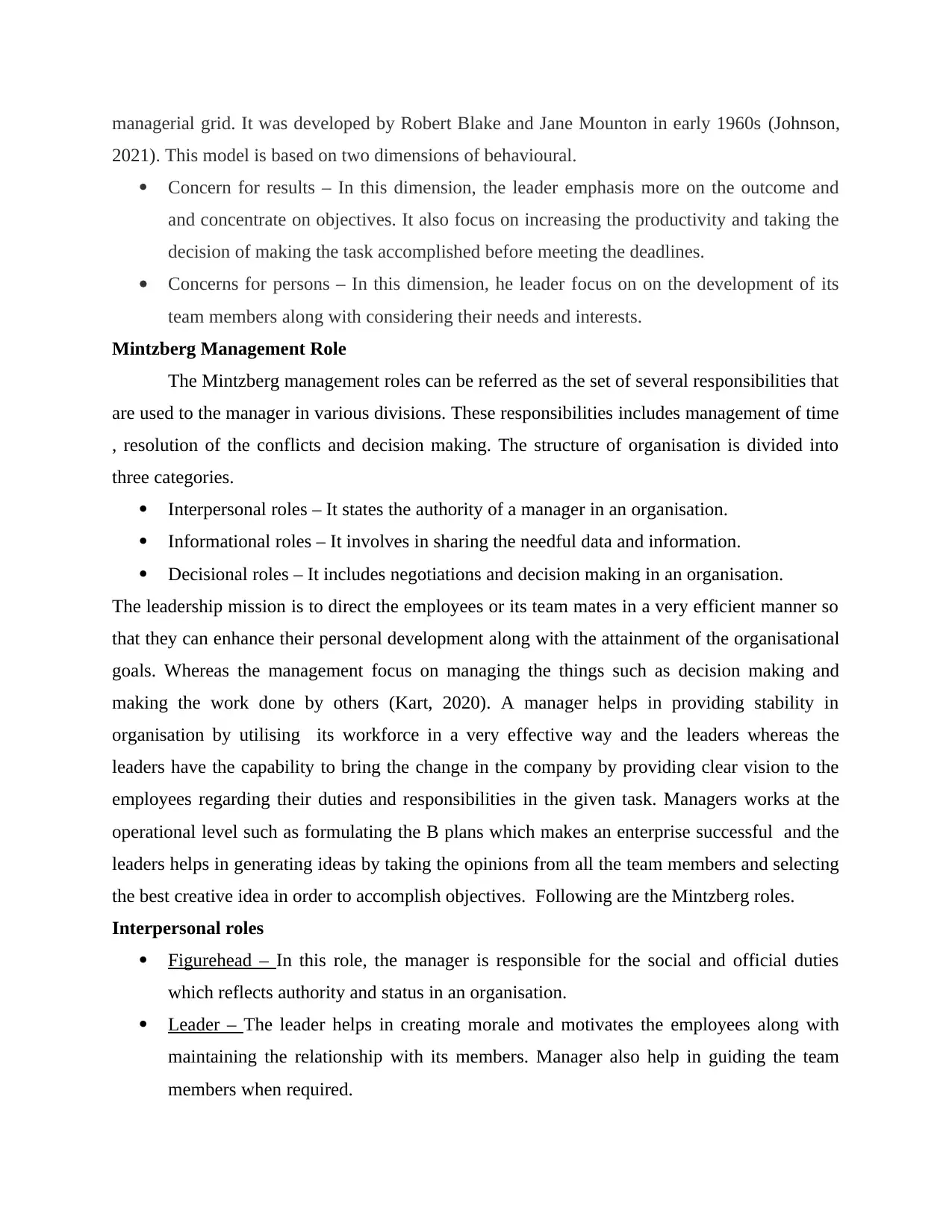
managerial grid. It was developed by Robert Blake and Jane Mounton in early 1960s (Johnson,
2021). This model is based on two dimensions of behavioural.
Concern for results – In this dimension, the leader emphasis more on the outcome and
and concentrate on objectives. It also focus on increasing the productivity and taking the
decision of making the task accomplished before meeting the deadlines.
Concerns for persons – In this dimension, he leader focus on on the development of its
team members along with considering their needs and interests.
Mintzberg Management Role
The Mintzberg management roles can be referred as the set of several responsibilities that
are used to the manager in various divisions. These responsibilities includes management of time
, resolution of the conflicts and decision making. The structure of organisation is divided into
three categories.
Interpersonal roles – It states the authority of a manager in an organisation.
Informational roles – It involves in sharing the needful data and information.
Decisional roles – It includes negotiations and decision making in an organisation.
The leadership mission is to direct the employees or its team mates in a very efficient manner so
that they can enhance their personal development along with the attainment of the organisational
goals. Whereas the management focus on managing the things such as decision making and
making the work done by others (Kart, 2020). A manager helps in providing stability in
organisation by utilising its workforce in a very effective way and the leaders whereas the
leaders have the capability to bring the change in the company by providing clear vision to the
employees regarding their duties and responsibilities in the given task. Managers works at the
operational level such as formulating the B plans which makes an enterprise successful and the
leaders helps in generating ideas by taking the opinions from all the team members and selecting
the best creative idea in order to accomplish objectives. Following are the Mintzberg roles.
Interpersonal roles
Figurehead – In this role, the manager is responsible for the social and official duties
which reflects authority and status in an organisation.
Leader – The leader helps in creating morale and motivates the employees along with
maintaining the relationship with its members. Manager also help in guiding the team
members when required.
2021). This model is based on two dimensions of behavioural.
Concern for results – In this dimension, the leader emphasis more on the outcome and
and concentrate on objectives. It also focus on increasing the productivity and taking the
decision of making the task accomplished before meeting the deadlines.
Concerns for persons – In this dimension, he leader focus on on the development of its
team members along with considering their needs and interests.
Mintzberg Management Role
The Mintzberg management roles can be referred as the set of several responsibilities that
are used to the manager in various divisions. These responsibilities includes management of time
, resolution of the conflicts and decision making. The structure of organisation is divided into
three categories.
Interpersonal roles – It states the authority of a manager in an organisation.
Informational roles – It involves in sharing the needful data and information.
Decisional roles – It includes negotiations and decision making in an organisation.
The leadership mission is to direct the employees or its team mates in a very efficient manner so
that they can enhance their personal development along with the attainment of the organisational
goals. Whereas the management focus on managing the things such as decision making and
making the work done by others (Kart, 2020). A manager helps in providing stability in
organisation by utilising its workforce in a very effective way and the leaders whereas the
leaders have the capability to bring the change in the company by providing clear vision to the
employees regarding their duties and responsibilities in the given task. Managers works at the
operational level such as formulating the B plans which makes an enterprise successful and the
leaders helps in generating ideas by taking the opinions from all the team members and selecting
the best creative idea in order to accomplish objectives. Following are the Mintzberg roles.
Interpersonal roles
Figurehead – In this role, the manager is responsible for the social and official duties
which reflects authority and status in an organisation.
Leader – The leader helps in creating morale and motivates the employees along with
maintaining the relationship with its members. Manager also help in guiding the team
members when required.
Paraphrase This Document
Need a fresh take? Get an instant paraphrase of this document with our AI Paraphraser
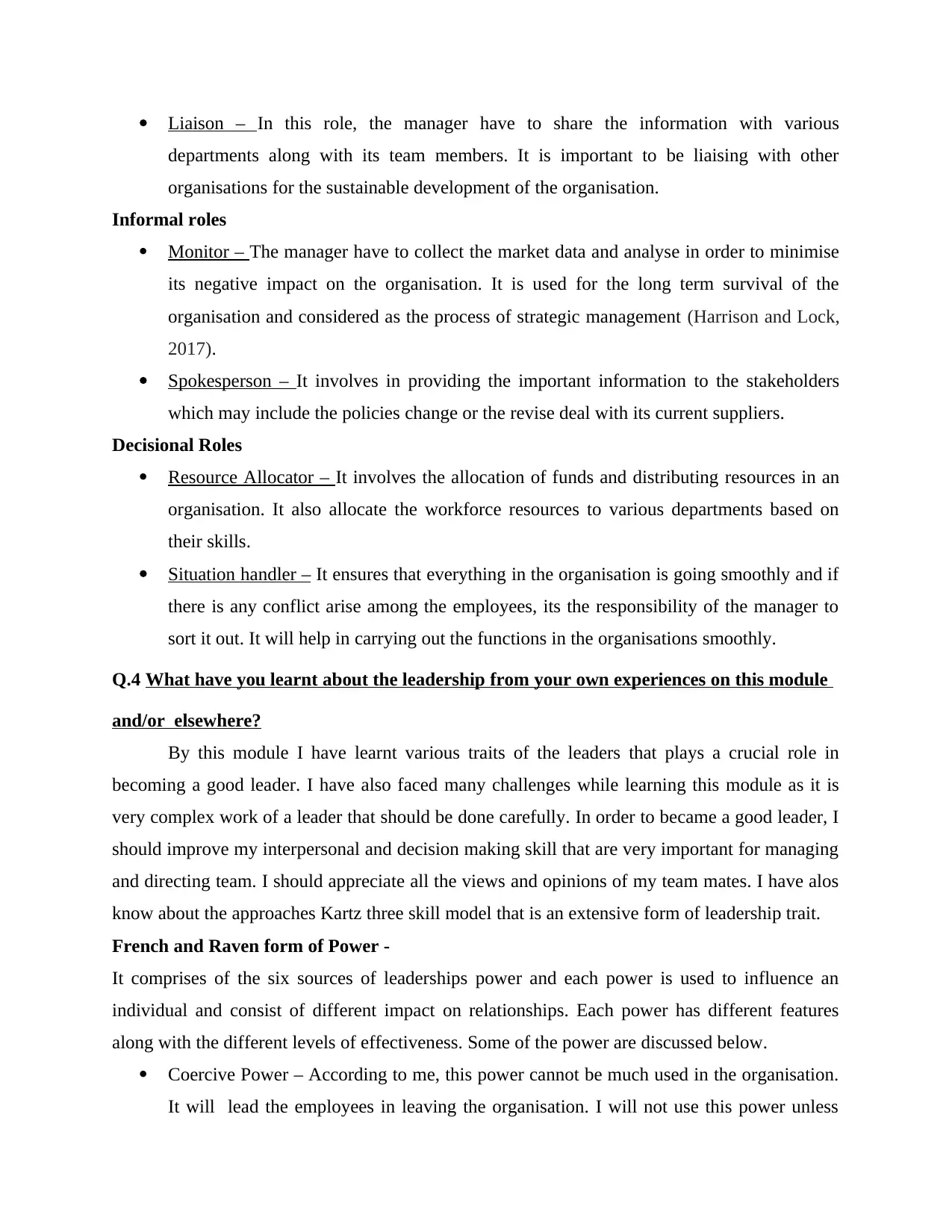
Liaison – In this role, the manager have to share the information with various
departments along with its team members. It is important to be liaising with other
organisations for the sustainable development of the organisation.
Informal roles
Monitor – The manager have to collect the market data and analyse in order to minimise
its negative impact on the organisation. It is used for the long term survival of the
organisation and considered as the process of strategic management (Harrison and Lock,
2017).
Spokesperson – It involves in providing the important information to the stakeholders
which may include the policies change or the revise deal with its current suppliers.
Decisional Roles
Resource Allocator – It involves the allocation of funds and distributing resources in an
organisation. It also allocate the workforce resources to various departments based on
their skills.
Situation handler – It ensures that everything in the organisation is going smoothly and if
there is any conflict arise among the employees, its the responsibility of the manager to
sort it out. It will help in carrying out the functions in the organisations smoothly.
Q.4 What have you learnt about the leadership from your own experiences on this module
and/or elsewhere?
By this module I have learnt various traits of the leaders that plays a crucial role in
becoming a good leader. I have also faced many challenges while learning this module as it is
very complex work of a leader that should be done carefully. In order to became a good leader, I
should improve my interpersonal and decision making skill that are very important for managing
and directing team. I should appreciate all the views and opinions of my team mates. I have alos
know about the approaches Kartz three skill model that is an extensive form of leadership trait.
French and Raven form of Power -
It comprises of the six sources of leaderships power and each power is used to influence an
individual and consist of different impact on relationships. Each power has different features
along with the different levels of effectiveness. Some of the power are discussed below.
Coercive Power – According to me, this power cannot be much used in the organisation.
It will lead the employees in leaving the organisation. I will not use this power unless
departments along with its team members. It is important to be liaising with other
organisations for the sustainable development of the organisation.
Informal roles
Monitor – The manager have to collect the market data and analyse in order to minimise
its negative impact on the organisation. It is used for the long term survival of the
organisation and considered as the process of strategic management (Harrison and Lock,
2017).
Spokesperson – It involves in providing the important information to the stakeholders
which may include the policies change or the revise deal with its current suppliers.
Decisional Roles
Resource Allocator – It involves the allocation of funds and distributing resources in an
organisation. It also allocate the workforce resources to various departments based on
their skills.
Situation handler – It ensures that everything in the organisation is going smoothly and if
there is any conflict arise among the employees, its the responsibility of the manager to
sort it out. It will help in carrying out the functions in the organisations smoothly.
Q.4 What have you learnt about the leadership from your own experiences on this module
and/or elsewhere?
By this module I have learnt various traits of the leaders that plays a crucial role in
becoming a good leader. I have also faced many challenges while learning this module as it is
very complex work of a leader that should be done carefully. In order to became a good leader, I
should improve my interpersonal and decision making skill that are very important for managing
and directing team. I should appreciate all the views and opinions of my team mates. I have alos
know about the approaches Kartz three skill model that is an extensive form of leadership trait.
French and Raven form of Power -
It comprises of the six sources of leaderships power and each power is used to influence an
individual and consist of different impact on relationships. Each power has different features
along with the different levels of effectiveness. Some of the power are discussed below.
Coercive Power – According to me, this power cannot be much used in the organisation.
It will lead the employees in leaving the organisation. I will not use this power unless
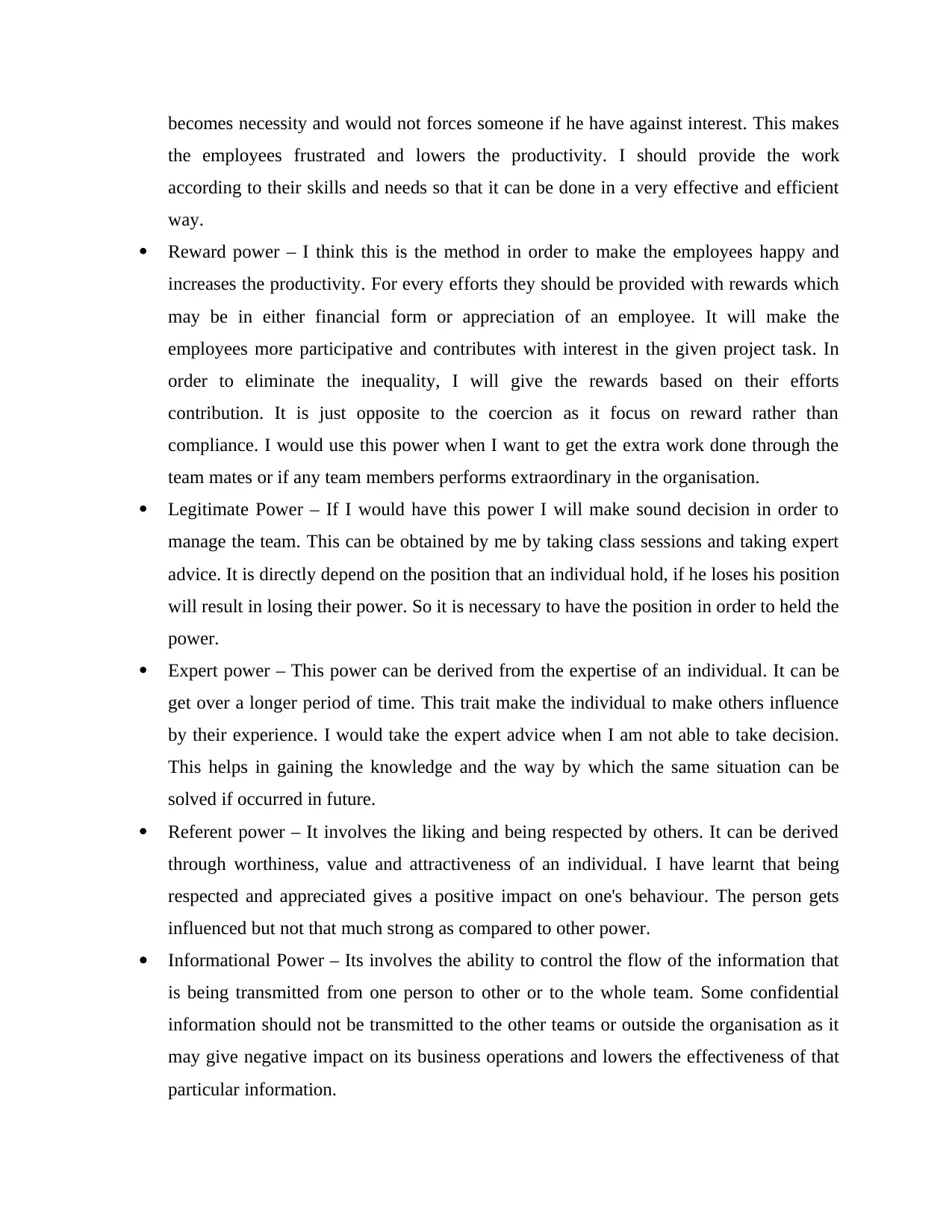
becomes necessity and would not forces someone if he have against interest. This makes
the employees frustrated and lowers the productivity. I should provide the work
according to their skills and needs so that it can be done in a very effective and efficient
way.
Reward power – I think this is the method in order to make the employees happy and
increases the productivity. For every efforts they should be provided with rewards which
may be in either financial form or appreciation of an employee. It will make the
employees more participative and contributes with interest in the given project task. In
order to eliminate the inequality, I will give the rewards based on their efforts
contribution. It is just opposite to the coercion as it focus on reward rather than
compliance. I would use this power when I want to get the extra work done through the
team mates or if any team members performs extraordinary in the organisation.
Legitimate Power – If I would have this power I will make sound decision in order to
manage the team. This can be obtained by me by taking class sessions and taking expert
advice. It is directly depend on the position that an individual hold, if he loses his position
will result in losing their power. So it is necessary to have the position in order to held the
power.
Expert power – This power can be derived from the expertise of an individual. It can be
get over a longer period of time. This trait make the individual to make others influence
by their experience. I would take the expert advice when I am not able to take decision.
This helps in gaining the knowledge and the way by which the same situation can be
solved if occurred in future.
Referent power – It involves the liking and being respected by others. It can be derived
through worthiness, value and attractiveness of an individual. I have learnt that being
respected and appreciated gives a positive impact on one's behaviour. The person gets
influenced but not that much strong as compared to other power.
Informational Power – Its involves the ability to control the flow of the information that
is being transmitted from one person to other or to the whole team. Some confidential
information should not be transmitted to the other teams or outside the organisation as it
may give negative impact on its business operations and lowers the effectiveness of that
particular information.
the employees frustrated and lowers the productivity. I should provide the work
according to their skills and needs so that it can be done in a very effective and efficient
way.
Reward power – I think this is the method in order to make the employees happy and
increases the productivity. For every efforts they should be provided with rewards which
may be in either financial form or appreciation of an employee. It will make the
employees more participative and contributes with interest in the given project task. In
order to eliminate the inequality, I will give the rewards based on their efforts
contribution. It is just opposite to the coercion as it focus on reward rather than
compliance. I would use this power when I want to get the extra work done through the
team mates or if any team members performs extraordinary in the organisation.
Legitimate Power – If I would have this power I will make sound decision in order to
manage the team. This can be obtained by me by taking class sessions and taking expert
advice. It is directly depend on the position that an individual hold, if he loses his position
will result in losing their power. So it is necessary to have the position in order to held the
power.
Expert power – This power can be derived from the expertise of an individual. It can be
get over a longer period of time. This trait make the individual to make others influence
by their experience. I would take the expert advice when I am not able to take decision.
This helps in gaining the knowledge and the way by which the same situation can be
solved if occurred in future.
Referent power – It involves the liking and being respected by others. It can be derived
through worthiness, value and attractiveness of an individual. I have learnt that being
respected and appreciated gives a positive impact on one's behaviour. The person gets
influenced but not that much strong as compared to other power.
Informational Power – Its involves the ability to control the flow of the information that
is being transmitted from one person to other or to the whole team. Some confidential
information should not be transmitted to the other teams or outside the organisation as it
may give negative impact on its business operations and lowers the effectiveness of that
particular information.
⊘ This is a preview!⊘
Do you want full access?
Subscribe today to unlock all pages.

Trusted by 1+ million students worldwide
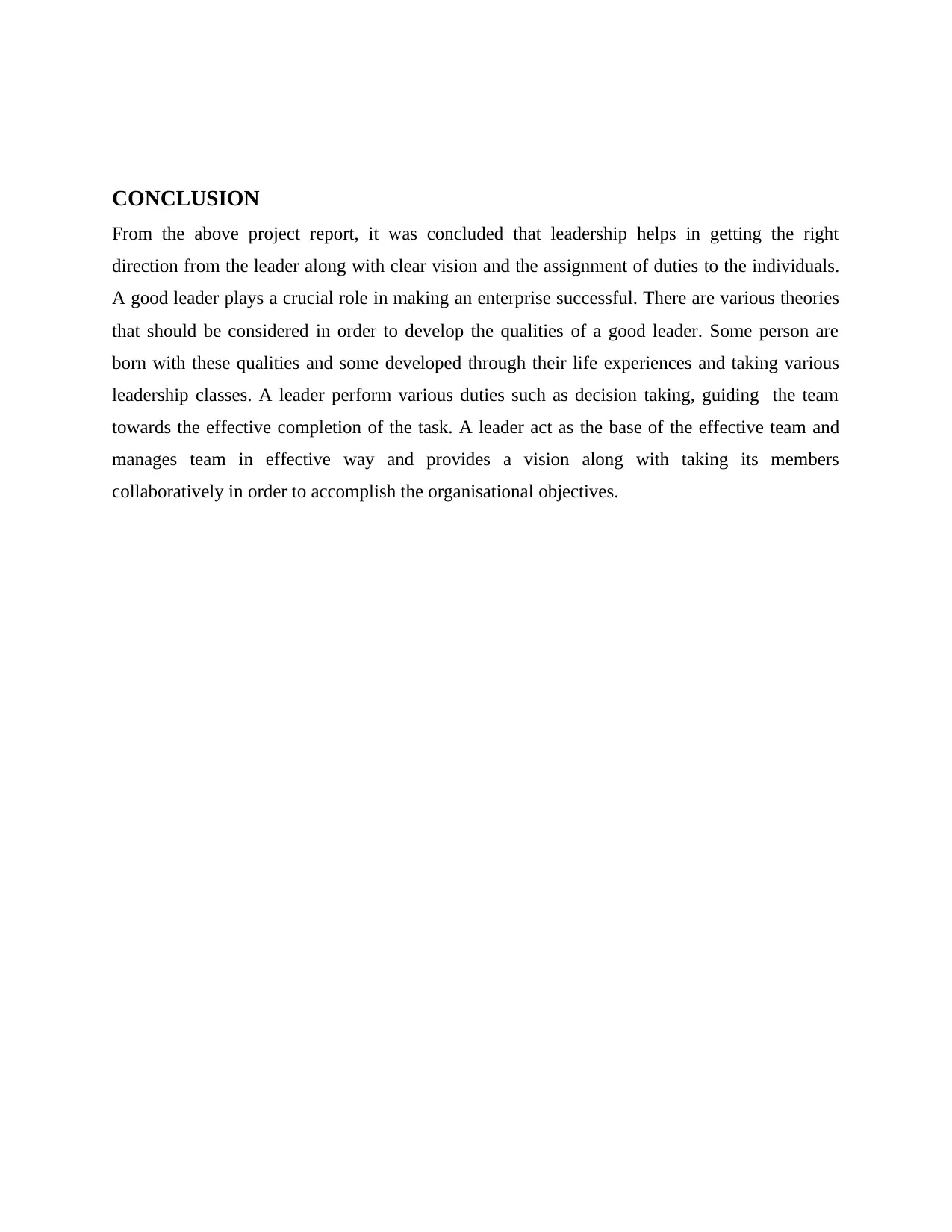
CONCLUSION
From the above project report, it was concluded that leadership helps in getting the right
direction from the leader along with clear vision and the assignment of duties to the individuals.
A good leader plays a crucial role in making an enterprise successful. There are various theories
that should be considered in order to develop the qualities of a good leader. Some person are
born with these qualities and some developed through their life experiences and taking various
leadership classes. A leader perform various duties such as decision taking, guiding the team
towards the effective completion of the task. A leader act as the base of the effective team and
manages team in effective way and provides a vision along with taking its members
collaboratively in order to accomplish the organisational objectives.
From the above project report, it was concluded that leadership helps in getting the right
direction from the leader along with clear vision and the assignment of duties to the individuals.
A good leader plays a crucial role in making an enterprise successful. There are various theories
that should be considered in order to develop the qualities of a good leader. Some person are
born with these qualities and some developed through their life experiences and taking various
leadership classes. A leader perform various duties such as decision taking, guiding the team
towards the effective completion of the task. A leader act as the base of the effective team and
manages team in effective way and provides a vision along with taking its members
collaboratively in order to accomplish the organisational objectives.
Paraphrase This Document
Need a fresh take? Get an instant paraphrase of this document with our AI Paraphraser
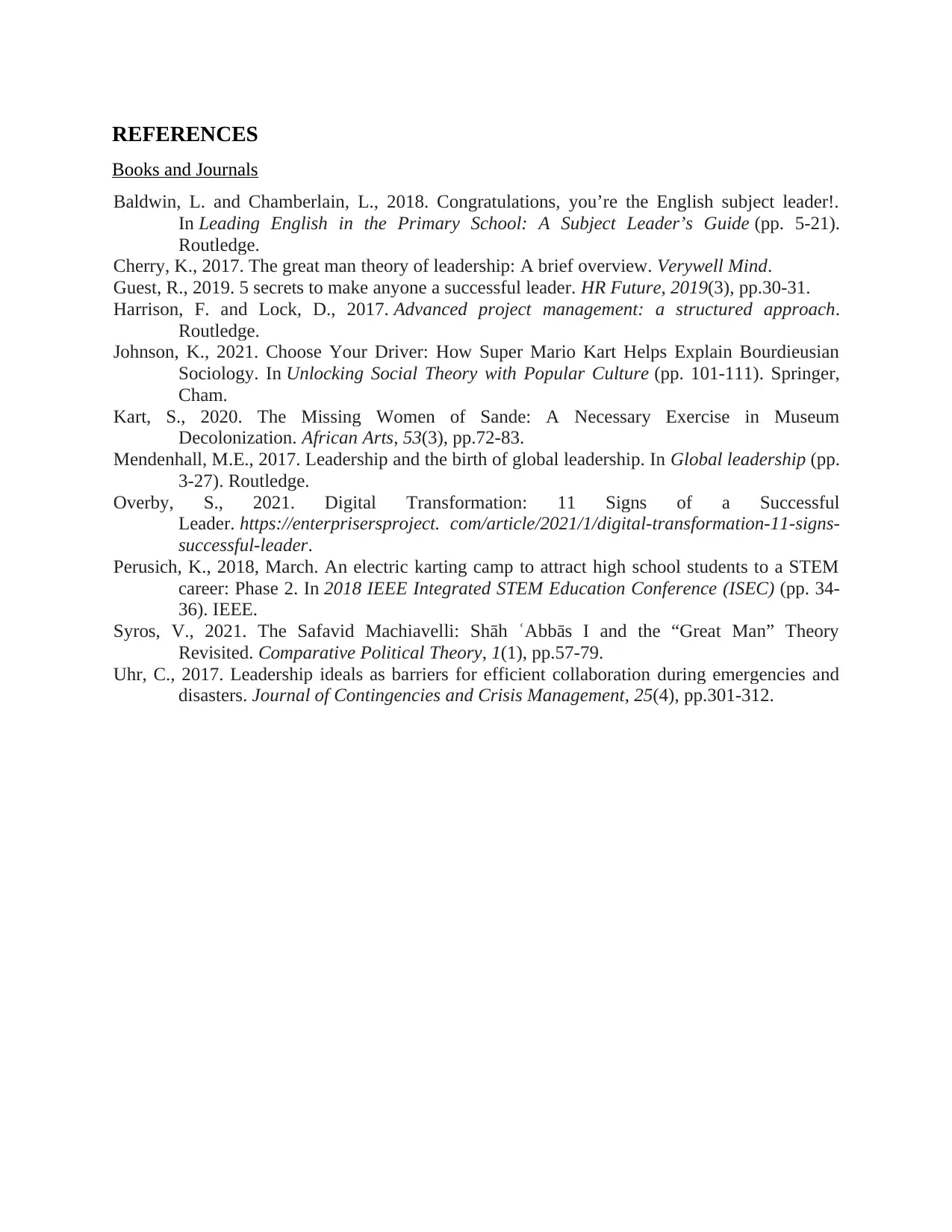
REFERENCES
Books and Journals
Baldwin, L. and Chamberlain, L., 2018. Congratulations, you’re the English subject leader!.
In Leading English in the Primary School: A Subject Leader’s Guide (pp. 5-21).
Routledge.
Cherry, K., 2017. The great man theory of leadership: A brief overview. Verywell Mind.
Guest, R., 2019. 5 secrets to make anyone a successful leader. HR Future, 2019(3), pp.30-31.
Harrison, F. and Lock, D., 2017. Advanced project management: a structured approach.
Routledge.
Johnson, K., 2021. Choose Your Driver: How Super Mario Kart Helps Explain Bourdieusian
Sociology. In Unlocking Social Theory with Popular Culture (pp. 101-111). Springer,
Cham.
Kart, S., 2020. The Missing Women of Sande: A Necessary Exercise in Museum
Decolonization. African Arts, 53(3), pp.72-83.
Mendenhall, M.E., 2017. Leadership and the birth of global leadership. In Global leadership (pp.
3-27). Routledge.
Overby, S., 2021. Digital Transformation: 11 Signs of a Successful
Leader. https://enterprisersproject. com/article/2021/1/digital-transformation-11-signs-
successful-leader.
Perusich, K., 2018, March. An electric karting camp to attract high school students to a STEM
career: Phase 2. In 2018 IEEE Integrated STEM Education Conference (ISEC) (pp. 34-
36). IEEE.
Syros, V., 2021. The Safavid Machiavelli: Shāh ʿAbbās I and the “Great Man” Theory
Revisited. Comparative Political Theory, 1(1), pp.57-79.
Uhr, C., 2017. Leadership ideals as barriers for efficient collaboration during emergencies and
disasters. Journal of Contingencies and Crisis Management, 25(4), pp.301-312.
Books and Journals
Baldwin, L. and Chamberlain, L., 2018. Congratulations, you’re the English subject leader!.
In Leading English in the Primary School: A Subject Leader’s Guide (pp. 5-21).
Routledge.
Cherry, K., 2017. The great man theory of leadership: A brief overview. Verywell Mind.
Guest, R., 2019. 5 secrets to make anyone a successful leader. HR Future, 2019(3), pp.30-31.
Harrison, F. and Lock, D., 2017. Advanced project management: a structured approach.
Routledge.
Johnson, K., 2021. Choose Your Driver: How Super Mario Kart Helps Explain Bourdieusian
Sociology. In Unlocking Social Theory with Popular Culture (pp. 101-111). Springer,
Cham.
Kart, S., 2020. The Missing Women of Sande: A Necessary Exercise in Museum
Decolonization. African Arts, 53(3), pp.72-83.
Mendenhall, M.E., 2017. Leadership and the birth of global leadership. In Global leadership (pp.
3-27). Routledge.
Overby, S., 2021. Digital Transformation: 11 Signs of a Successful
Leader. https://enterprisersproject. com/article/2021/1/digital-transformation-11-signs-
successful-leader.
Perusich, K., 2018, March. An electric karting camp to attract high school students to a STEM
career: Phase 2. In 2018 IEEE Integrated STEM Education Conference (ISEC) (pp. 34-
36). IEEE.
Syros, V., 2021. The Safavid Machiavelli: Shāh ʿAbbās I and the “Great Man” Theory
Revisited. Comparative Political Theory, 1(1), pp.57-79.
Uhr, C., 2017. Leadership ideals as barriers for efficient collaboration during emergencies and
disasters. Journal of Contingencies and Crisis Management, 25(4), pp.301-312.
1 out of 11
Related Documents
Your All-in-One AI-Powered Toolkit for Academic Success.
+13062052269
info@desklib.com
Available 24*7 on WhatsApp / Email
![[object Object]](/_next/static/media/star-bottom.7253800d.svg)
Unlock your academic potential
Copyright © 2020–2025 A2Z Services. All Rights Reserved. Developed and managed by ZUCOL.




